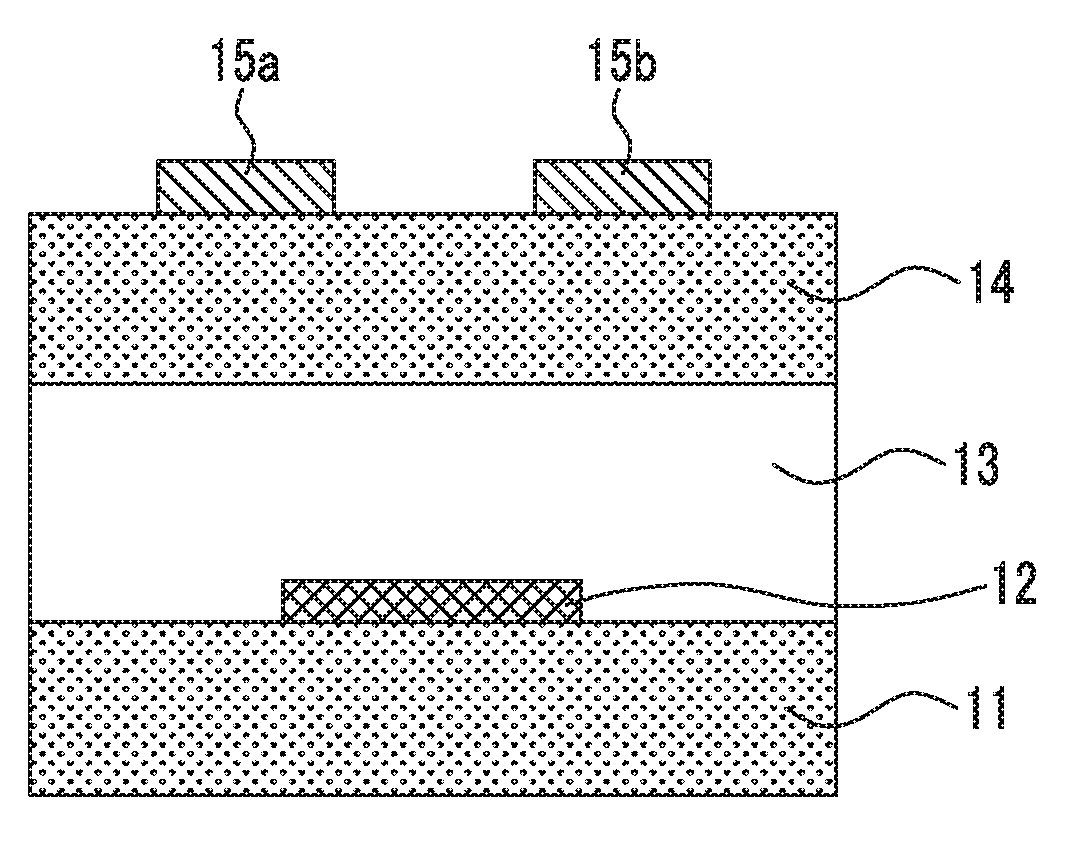Organic Transistor, Compound, Organic Semiconductor Material for Non-Light-Emitting Organic Semiconductor Device, Material for Organic Transistor, Coating Solution for Non-Light-Emitting Organic Semiconductor Device, and Organic Semiconductor Film for Non-Light-Emitting Organic Semiconductor Device
- Summary
- Abstract
- Description
- Claims
- Application Information
AI Technical Summary
Benefits of technology
Problems solved by technology
Method used
Image
Examples
example 1
Synthesis Example 1
Synthesis of Compounds 1 to 3, 5, 11, 13, 15, 16, 24, 31, and 32 and Intermediate Compounds e, f, and g
[0340]According to a specific synthesis procedure shown in the following scheme 1, compounds 1 to 3, 5, 11, 13, 15, 16, 24, 31, and 32 as the compound represented by Formula (1) and intermediate compounds e, f, and g were synthesized.
[0341]A process will be specifically described in which the intermediate compound e represented by Formula (3), the intermediate compound f represented by Formula (3), and then the intermediate compound g represented by (3) are synthesized from the following compound d.
[0342](Synthesis of Compound e)
[0343]5.0 g (12.82 mmol) of the compound d was dissolved in 40 ml of N,N′-dimethylacetamide, 360.0 mg (0.51 mmol) of PdCl2(PPh3)2 was added thereto in a nitrogen atmosphere, and then the resulting solution was heated to an internal temperature of 80° C. After 4 hours, the solution was left to cool to room temperature, and 1 N HCl and ethy...
example 2
Preparation / Evaluation of Element
[0358]All of the materials used for preparing elements were purified by sublimation. Through high-performance liquid chromatography (TOSOH CORPORATION, TSKgel ODS-100Z), it was confirmed that the materials had purity (area ratio for absorption intensity at 254 nm) of equal to or higher than 99.5%.
[0359]
[0360]Each of the compounds of the present invention or the comparative compounds (1 mg each) was mixed with toluene (1 mL) and heated to 100° C., thereby obtaining a coating solution for a non-light-emitting organic semiconductor device. In a nitrogen atmosphere, the coating solution was cast onto a substrate for measuring FET characteristics that was heated to 90° C., thereby forming an organic semiconductor film for a non-light-emitting organic semiconductor device. In this way, an organic transistor element of Example 2 for measuring FET characteristics was obtained. As the substrate for measuring FET characteristics, a silicon substrate comprising...
example 3
Formation of Semiconductor Active Layer (Organic Semiconductor Layer) by Using Compound and Binder Together
[0380]Each of the compounds of the present invention or the comparative compounds (1 mg each) was mixed with 1 mg of PαMS (poly(α-methylstyrene, Mw=300,000), manufactured by Sigma-Aldrich Co, LLC.) and toluene (1 mL), and the mixture was heated to 100° C., thereby obtaining a coating solution. Organic transistor elements for measuring FET characteristics were prepared and evaluated in the same manner as in Example 2, except that the coating solution obtained as above was used.
[0381]The obtained results are shown in the following Table 2.
TABLE 2ThresholdOrganicCarriervoltage shiftsemiconductormobilityafter repeatedElement No.material(cm2 / Vs)drivingNoteElement 12Compound 18.5 × 10−2APresentinventionElement 13Compound 51.5 × 10−1APresentinventionElement 14Compound 117.1 × 10−2APresentinventionElement 15Compound 168.4 × 10−2APresentinventionComparativeComparative3.0 × 10−5CComparat...
PUM
 Login to View More
Login to View More Abstract
Description
Claims
Application Information
 Login to View More
Login to View More - R&D
- Intellectual Property
- Life Sciences
- Materials
- Tech Scout
- Unparalleled Data Quality
- Higher Quality Content
- 60% Fewer Hallucinations
Browse by: Latest US Patents, China's latest patents, Technical Efficacy Thesaurus, Application Domain, Technology Topic, Popular Technical Reports.
© 2025 PatSnap. All rights reserved.Legal|Privacy policy|Modern Slavery Act Transparency Statement|Sitemap|About US| Contact US: help@patsnap.com



